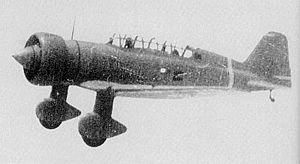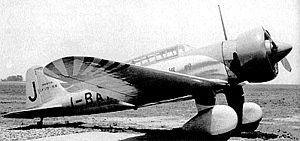Mitsubishi Ki-15 Video - Picture

|
|
Mitsubishi Ki-15
Ki-15 "Babs"

Picture - Mitsubishi Ki-15-I (Army Type 97 Command Reconnaissance Plane)
Role: Military reconnaissance aircraft, light bomber
Manufacturer: Mitsubishi
First flight: May 1936
Introduced: May 1937
Retired: 1945 (Japan)
1951 (China)
Primary users: IJA Air Force
IJN Air Service
Number built: approx. 500
The Mitsubishi Ki-15 (ä¹ä¸å¼å¸ä»¤é¨åµå¯æ©, Kyunana-shiki sireibu teisatsuki) was a Japanese reconnaissance aircraft and a light attack bomber of the Second Sino-Japanese War and Pacific War. It began as a fast civilian mail plane. It was a single-engine, low-wing, cantilever monoplane with a fixed tailwheel undercarriage; it carried a crew of two. It served with both the Imperial Japanese Army and Navy (as the C5M). During World War II it was nicknamed "Babs" by the Allies.
Design and development
The Ki-15 was designed by the Mitsubishi corporation to meet an Imperial Japanese Army Air Force requirement of 1935 for a two-seat, high-speed reconnaissance aircraft. The resulting aircraft was a low-wing cantilever monoplane with a fixed, spatted undercarriage, similar to other all-metal stressed-skin monoplanes developed elsewhere in 1930s, such as the Heinkel He 70 and the Northrop Alpha. Power was by a single Nakajima Ha-8 radial engine, giving 560 kW (750 hp) at 4,000 m (13,120 ft). The first prototype flew in May 1936, with testing proving successful, the aircraft meeting all performance requirements, reaching a speed of 481 km/h (299 mph) and showing good handling characteristics.
Service testing was completed without difficulty and the type was ordered into production under the official designation Army Type 97 Command Reconnaissance Plane Model 1 In May 1937, a year after the first flight, delivery of the first of 437 production aircraft to the army began.
World record flight to Europe and other civilian use
Main article: Kamikaze (1937 aircraft)

Picture - Mitsubishi Ki-15 Karigane aircraft, (registration J-BAAI) sponsored by the newspaper Asahi Shimbun.
Despite the relatively weak engine and fixed undercarriage, the Ki-15 was remarkably fast. During the initial flight testing, the Asahi newspaper Asahi Shimbun obtained permission to purchase the second prototype. The aircraft was given the designation Karigane (Wild Goose), flying on 19 March 1937, being named Kamikaze and registered as J-BAAI. It was the first Japanese-built airplane to fly to Europe and caused a sensation in 1937 by making the flight between Tokyo and London, for the Coronation of King George VI, between 6 April 1937 and 9 April 1937 in a flight time of 51 hours, 17 minutes and 23 seconds, a world record at the time Following the success of the Japan-England flight, a small number of Ki-15s were sold to civil customers. One of the early production aircraft was named "Asakaze" (J-BAAL) and was also used by the "Asahi Shimbun"; others were used by various civilian operators as mail planes.
Operational history
The Ki-15-I was almost immediately placed into operational service at the beginning of the war with China in 1937. The aircraft proved useful in the early period of the Second Sino-Japanese War and performed missions deep into Chinese strategic rear areas, as far as reaching Lanzhou. Its high speed gave it a distinct advantage until the Chinese Air Force acquired Soviet Polikarpov I-16 fighters. This aircraft was used for level bombing, close support and photo reconnaissance before being eventually replaced by the Mitsubishi Ki-30.
Plans were already in hand to improve the Ki-15-I, and in September 1939 the Ki-15-II was put into production with the 671 kW (900 hp) Mitsubishi Ha-26-1; the smaller diameter of this both reduced drag and overcame one of the major shortcomings of the initial version: poor forward field of view past the large-diameter of the initial Nakajima Kotobuki engine. The improved version entered production in September 1939 as the Ki-15-II.
The Japanese Navy, impressed by the performance of this aircraft, ordered 20 examples of the Ki-15-II under the designation âNavy Type 98 Reconnaissance Plane Model 1," or Mitsubishi designation C5M1, even before the Army. The Navy acquired subsequently 30 C5M2 aircraft which had an even more powerful 708 kW (949 hp) Nakajima Sakae 12 engine. They were used for reconnaissance duties. In a subsequent upgrade, the army also experimented with an even more powerful engine with 783 kW (1,050 hp) Mitsubishi 102 radial in the Ki-15-III which did not enter production.
When production ended, approximately 500 examples of all versions of the Ki-15 had been built, the majority in front-line service when the Pacific War began. By 1943, the Ki-15 had been relegated to second-line roles, but numbers were expended in kamikaze attacks in the closing stages of World War II.
Variants
Karigane I : Prototype version for civilian use
Ki-15-I (Army Type 97 Command Reconnaissance Plane Model 1) : Initial production variant for the Japanese Army, with Nakajima Ha-8 (Army Type 94) 640 hp at take-off, 900 hp at 11,810 ft (3,600 m)
Ki-15-II (Army Type 97 Command Reconnaissance Plane Model 2) : Improved Army production version with smaller, more powerful engine 14-cilinder Mitsubishi Ha-25-I (Army Type 99 Model 1) , with 850 hp at take-off, 900 hp at 11,810 ft. This gave an increased maximum speed of 317 mph at 14,205 ft (510 km/h at 4,300 m), roughly comparabile with fighters like Hawker Hurricane or the Nakajima Ki-43 Hayabusa. The climb was even more improved: 16,405 ft (5,000 m) in 6 min 49 sec (6,83 min). This was archivied despite the increase in weight (empty, normal, max: 3,510 vs 3,084 lb, normal 4,826 vs 4,482 and max 5,470 vs 5,071 lb). Maiden flight in June 1938, production started in september 1939
Ki-15-III : Proposed upgraded version, did not enter production version. It had the Mitsubishi Ha-102 engine (1,080 hp at take-off, 1,055 hp at 9,185 ft and 950 hp at 19,030 ft), with a top speed of 329 mph (530 km/h), roughly the same of Ki-46 Dinah. But this latter was expected to be far better in other ways (endurance, two engine, etc), so this version never went in production, even if it was proposed since 1939
C5M1 (Navy Type 98 Reconnaissance Plane Model I) : Improved version of Ki-15-I for the Japanese Navy
C5M2 (Navy Type 98 Reconnaissance Plane Model 2) : Upgraded version of C5M1 with more powerful engine for the Japanese Navy
Operators
Pre-war
Japan
Imperial Japanese Army Air Force
Imperial Japanese Navy Air Service
Various civilian entities, including the Asahi Shimbun
Post-war
People's Republic of China
Chinese Communist Air Force operated an unknown number of captured aircraft. A number of abandoned Ki-15s were captured near Harbin in June 1946, and by 1948, they were completely repaired and entered service as trainers. The last two Ki-15 retired in 1951.
Specifications (Ki-15-I)
Data from The Concise Guide to Axis Aircraft of World War II
General characteristics
Crew: 2
Length: 8.7 m (28 ft 6½.5 in)
Wingspan: 12.0 m (39 ft 4½.5 in)
Height: 3.35 m (11 ft 0 in)
Wing area: 20.36 m² (219.16 ft²)
Empty weight: 1,400 kg (3,086 lb)
Loaded weight: 2,033 kg (4,482 lb)
Max takeoff weight: 2,300 kg (5,071 lb)
Powerplant: 1x Nakajima Ha-8 9-cylinder radial piston, 477 kW (640 hp)
Performance
Maximum speed: 480 km/h (259 kn, 298 mph) at 4,000 m (13,125 ft)
Cruise speed: 320 km/h (173 kn, 199 mph) at 5,000 m (16,404 ft)
Range: 2,400 km (1,297 nmi, 1,491 mi)
Service ceiling: 11,400 m (37,400 ft)
Climb to 5,000 m (16,404 ft): 8 minutes 27 sec
Armament
1x 7.7 mm (0.303 in) machine gun
250 kg (551 lb) of bombs
Bibliography
Donald, David, ed (1997). The Encyclopedia of World Aircraft. Prospero Books. pp. pg 652. ISBN 1-85605-375-X.
Gunston, Bill (1999). Illustrated Directory of Fighting Aircraft of World War II. London: Zenith Press. ISBN 0760307229.
Francillon, René J. (1979). Japanese Aircraft of the Pacific War. London: Putnam & Company Ltd.. ISBN 0-370-30251-6.
Mikesh, Robert C.; Shorzoe Abe (1990). Japanese Aircraft, 1910-1941. Annapolis, MD: Naval Institute Press. ISBN 1557505632.
Mondey, David (1996). The Concise Guide to Axis Aircraft of World War II. London: Chancellor Press. ISBN 1-85152-966-7.
Mitsubishi Ki-15 Pictures
Living Warbirds: The best warbirds DVD series.
Source: WikiPedia